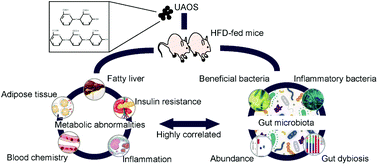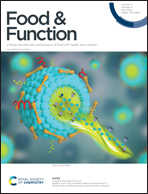Unsaturated alginate oligosaccharides attenuated obesity-related metabolic abnormalities by modulating gut microbiota in high-fat-diet mice†
Abstract
Gut microbiota plays an important role in the high-fat diet (HFD)-induced obesity and related metabolic syndrome (MetS). Our previous study has demonstrated that unsaturated alginate oligosaccharides (UAOS) degraded by alginate lyase possess significant anti-obesity effects in HFD-fed mice. Herein, we further established that UAOS could significantly ameliorate obesity-related metabolic abnormalities, including hyperlipidemia, insulin resistance and low-grade inflammation. Particularly, the beneficial effect of UAOS on these metabolic abnormalities could be significantly reversed by antibiotic supplementation. Subsequently, the microbiological analysis has revealed that UAOS treatment can modulate the overall composition of the gut microbiota, which is highly associated with metabolic parameters. UAOS supplementation can partially reverse the gut dysbiosis induced by HFD-diet or antibiotics. Specifically, UAOS treatment selectively increased the relative abundance of beneficial intestinal bacteria (e.g. Lactobacillus and Akkermansia genus) and decreased the abundance of inflammogenic bacteria (e.g. Bacteroides and Parabacteroides). These results suggest that UAOS can attenuate the HFD-induced obesity and related abnormalities through modulating gut microbiota, indicating that UAOS can act as potent prebiotic agents in treating obesity and related metabolic diseases.



 Please wait while we load your content...
Please wait while we load your content...